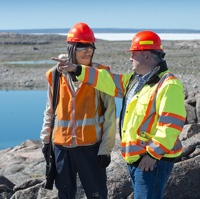Steering Baffinland’s Mary River Project

1 of 2A Baffinland polar bear monitor talks with Tom Paddon (R), CEO and president of Baffinland Iron Mines, at Steensby in July 2012. — Photo by Marc
1 of 2A Baffinland polar bear monitor talks with Tom Paddon (R), CEO and president of Baffinland Iron Mines, at Steensby in July 2012. — Photo by Marc Pike/courtesy Baffinland Iron Mines Corp.
As the president and CEO of Baffinland Iron Mines Corporation, Tom Paddon leads a hugely talented team in the development of the Mary River Project in the northern part of Baffin Island, which lies in the Qikiqtani region of Nunavut.
“It’s a great deposit—more than 65 per cent Fe and primarily lump—with deposits 2 and 3 immediately adjacent at similar grade and another half dozen deposits nearby,” said Paddon. “We’ll start mining later this year and ship ore out in the open water season of 2015.”
Paddon began his career in mining in January 1997 with Inco’s Voisey’s Bay Project in Labrador. The company had acquired the development in the previous fall and was beginning to get it into high gear when they called Paddon and asked if he’d join the team.
“I was born in Labrador and, apart from attending boarding school in England, spent a good part of my life there,” said Paddon. “My hometown of North West River was small by most standards but contained the three main cultures that exist in that part of the world: Innu, Inuit and Métis. The cultural mix in my hometown turned out to be important later.”
When Inco called, Paddon was doing project management on a remote site in Labrador that had challenges in the areas of supply lines, labour availability, stakeholder expectations, quality assurance and seasonal schedules.
“These were all topics that were going to appear at Voisey’s Bay but on a much bigger scale,” he said. "It sounded interesting and so I took the job."
The primary challenge turned out to be negotiating Impacts and Benefits Agreements with the Innu and Inuit, given the deposit was located on lands that were part of two separate, unresolved land claims with the federal and provincial governments.
“Being able to forge strong relationships across cultural boundaries was critical and my personal background had some value there,” Paddon said.
Over the past two decades working in the North, Paddon has witnessed remarkable growth in the industry’s understanding of what it really means to work and be successful in the North.
“It’s a given now that success means not just building a safe and sustainable business but also ensuring that stakeholders participate in meaningful ways in virtually all aspects of the operation,” he said. “Employment is an obvious benefit, but thinking more broadly about how our presence will build stronger, healthier communities where people are glad to have you as a neighbour is a prerequisite—and achievable.”
Paddon believes the mining industry in Canada has evolved enormously in the last 20 years in terms of its realization that its self-interest lies in broader engagement on all sorts of levels—including with Aboriginal Peoples, with women and with those who focus exclusively on environmental issues.
“Finding ways to understand the perspectives and needs in these areas are among the ingredients that will make our businesses even more successful in the future,” Paddon said. “I really think that for all the progress that’s been made we’re only in the first chapter—there’s enormous potential to do more, and that will create value for our businesses and our society.”
Canadian mining is of course challenged by competition for capital and markets from developers who take a less enlightened view than is required, said Paddon, but there are global initiatives underway that seek to level the playing field. There are still those who look to cut corners, whether it’s in safety, environmental responsibility or stakeholder engagement.
“We can do more to ensure that the bad actors who do nothing less than call all of our reputations into question are identified and sanctioned,” he said. “Our industry doesn’t need them and in a real sense can’t afford them.”
Baffinland's most important internal focus at the moment is building a new workplace culture. A year ago there were a dozen people on site during the winter; this year on any given day there were more than 400—and it’s a fly-in, fly-out site, meaning there are always many who are at home on their time off.
“We’re building a safe, respectful culture that takes different languages, levels of mining experience and ways of approaching situations into consideration so that we have a successful business,” said Paddon.
Off site, the company is looking to build on the foundations of its stakeholder agreements to see broad success for both the business and the Inuit of North Baffin.
“Beyond the immediate, we’re working on plans to expand past this initial development and increase production,” Paddon said. “It’s an exciting time for all of us.”
The Mary River Project is a proposed iron ore mine located on North Baffin Island in the Qikiqtani region of Nunavut. Its remote location 160 kilometres south of Pond Inlet (Mittimatalik) and 1,000 kilometres northwest of Iqaluit is in part why the deposit hasn’t been developed since its discovery nearly 50 years ago; however, Baffinland has successfully met the geographical challenges.
Mary River is one of the largest and richest undeveloped iron ore projects in the world, comprising 365 million tonnes of high-grade, direct-ship lump and fine iron ore that can be mined, crushed and screened without further processing. The development will involve the construction, operation and reclamation of an open-pit mine—North America’s first at this latitude—with an estimated optimized output of between 18 and 30 million tonnes per year of ore.
Drilling down
NameTom PaddonFamilyPersonal hero: My father was born in Labrador and left for an education. He came back as a doctor and began his career by travelling on schooner and dog team to see patients. He raised money to build hospitals and schools in the region and he eradicated tuberculosis as a threat to the Innu, Inuit and Métis. He also served in the Canadian Navy as a doctor through all the war years. He was the most open, welcoming and humble man I’ve ever met. If you’d suggested he was a hero he’d have chuckled and changed the subject. Inspiration for living: Like many in the mining business, I spent too much time away from home for too many years; now I see more of my family and I’m delighted to be a bigger part of their lives. Must readsMust-read: The EconomistGreatest career momentSeeing the Voisey’s Bay Project grow from start to maturity. “When I joined Inco in 1997 I was very junior and we hadn’t even started the environmental assessment. Being a part of all the challenges along the way—in permitting, negotiating stakeholder agreements, implementing them, construction, startup and eventually full operations—was a great experience. Eventually leaving the company (by then Vale Newfoundland & Labrador) as its leader with a safe, mature operation in place was very satisfying. Together we built something that had real value to all."QuotableFavourite quote: Help others. Judge yourself.




